As schoolgirls, my mother and her sisters, walking home from the Convent at teatime, tried to guess what goodies their mother might have made that day. When oduputtu was on the menu, the guessing stopped well before they even got to the gate – the magical fragrance drifted up the kitchen chimney and down the hill, drawing them home in excited anticipation. Everyone knew it was oduputtu with honey for tea!
Of all the many creative ways that rice is transformed, I can’t think of any other that is quite so simple and yet so unusual.
Cooked in a shallow, 9″ – 10″ wide earthenware pan known as a “wodu” or “odu”, oduputtu is made from an unfermented rice batter, seasoned with salt. Sometimes a little fenugreek seed is ground along with the rice. So far, so simple. What really makes it unique, however, is the seasoning that is applied to the pan. No oil is used, but before the batter is poured, the pan is rubbed with a lump of resin, known as “banda” (bun-dah). This is the hardened exudate of the Indian Copal tree, Vateria indica. It releases a delicate fragrance but very little smoke.The resin vaporizes quickly, leaving barely discernible traces on the crisp base of the oduputtu, which takes on a subtle, elusive, fragrance that may as well be in the scented air.
Vateria indica, the Indian Copal tree, is known as “banda mara” in the Kodava language. The tree is the source of “Malabar tallow”, a fat extracted from the mature, dried fruit and used in cosmetics and confectionery. The fruit, when peeled, reveals a creamy white flesh with a taste reminiscent of fresh coconut. In the past, small quantities of this fat could be extracted for home use. (Fat was also extracted from the seeds of Garcinia gummi-gutta). But the Banda tree is not as abundant as it might once have been, and many of the trees that remain tend to be sadly overexploited. It does grow fairly easily, so if you happen to live in a suitable zone and have a few spare patches of land, do plant some Indian Copal trees!
The resin, classified into various grades, finds use in varnish and incense manufacture. It is also used in traditional Indian medicine, in both internal and external applications. In Sri Lanka, the bark of the tree was sometimes used to inhibit fermentation in the process of making jaggery from toddy. I haven’t come across any other significant culinary uses yet, so if you know of any, I’d love to hear about it!
The name ” banda” conjures up images of the famed spice islands in Indonesia. Is there a link? As for oduputtu, I enjoy speculating as to how it came into being. Given the long list of medicinal and therapeutic properties attributed to it, was this a clever way to make the medicine go down? Or, perhaps it was born of some creative cook’s cabin fever, some long, dark, monsoon ago?
Whatever its origins, it is a fragrant delight to prepare and to eat.
Oduputtu
Rice pancakes with a fancy air about them.
- 1 cup raw rice, soaked for 2 – 3 hours
- 2 tbsp soft, cooked rice
- 1/4 tsp salt
- A small lump of “banda”
Grind the soaked raw rice and the cooked rice together to a smooth batter and add the salt. Add water as needed to make a batter with a consistency a little thinner than single cream.
Heat the pan* on a low, steady flame until it is evenly heated. Keep the heat on medium-low. Grasp one side of the pan with a piece of cloth and rub the banda firmly onto the heated pan, working in a circular motion. Breathe in that delicate scent.
Quickly pour in about 1/3 cup of batter, tipping the pan as you pour to coat the inside, leaving a margin of a few inches around the edge. Wait until the surface bubbles disappear and the batter looks just set. Place a lid over the pan. Remove the lid after a couple of minutes.
When the edges start to turn golden brown and lift away from the pan, slide a knife around the edges and lift the oduputtu out.The puttu is cooked when the base is crisp and insides soft and white.
Repeat.
In my grandmother’s home , these were most often eaten with butter and honey as a teatime snack, or, quite on the other end of things, with a sheep’s head curry, as part of a more substantial meal.
Makes 8 – 10 pieces.
Serve with a beatific smile.
* The clay pan needs to be seasoned before use. The process involves burning coconut husk and shell in the pan and rubbing the burnt cinders and ash into the surface.

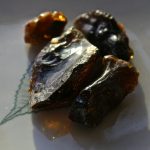
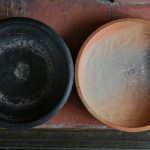
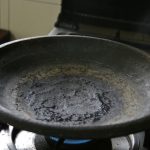
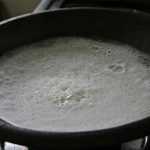
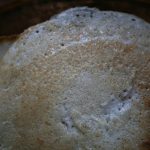
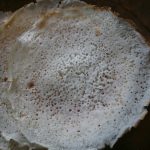
I was looking up information on Kachampuli to send to a friend who wants to cook pandhi curry without the real Mc Coy and by a stroke of genius came across your blog and coincidentally her daughter did too . Your blog is an absolute delight and have yet to read all the posts, But just this first one left me in a spell . The next best thing to actually being there in Coorg or the maple country . Love your writing and the pics . Neat Neat Neat.
Am so looking forward to soaking up your posts and pictures this afternoon. Just amazing , how people who live off the land or in the good old days lived and ate very scientifically , so much nutrition went in so easily , and there was such little waste .
warm regards Jyoti Kalapa
Hello, welcome, and thank you for your kind words, and for the feedback, Jyoti!
I’m so pleased to know that you’re enjoying reading these posts, and I’d love to hear your thoughts and experiences along these lines. Interaction of this kind is exactly what I had in mind when I started blogging.:-)
I hope your friend finds what she needs to make a good pandi curry !
Shalini
p.s:Does your handle indicate that you’re one of the lucky Mercara “Convent” alumni?!
well I am mad conventie all right but not form Saint Josephs Mercar:-( ! Still like all conventies I am very proud of my Alma Mater ” Sacred Heart Convent Jamshedpur”. I am not a Kodvathi, I was born and brought up in the industrial town of JAmshedpur , very modern , industrial , sanitised , so far removed from the land though we all owed our very bread and butter to the Iron and other ores mined form the earth, and with a culture and ethos (read clubs , British Bada Sahib collar and tie and eggnog parties at Christmas ) far removed form the state it belonged too. Yet have to credit to the Tatas for preserving and supporting the many tribes ethnic to the region of Jamshedpur and Tatanagar and inculcating strong values of comminity in us . I suppose that is true of Coorg in another context a community and culture so unique and distinct from anywhere else in the country, but it coexisted wonderfully with the British Planters and imbibed much that added to it’s charm and richness . I am married to a Kodava and have tried to absorb and learn whatever I can . I too drove through forests very often in my childhood but only to visit a mining town . Shalini I will bug you incessantly with questions and observations. I am so excited to read everything and must show it to my mother in law, she has very few relatives left in Kodagu and your posts will really gladden her heart. I could write reams about all that I have read and heard about the intrepid brave and beautiful people of Coorg , but t aht would be like hauling coals to Jamshedpur or mushrooms to Coorg . Today it ie Coorg is to some extent a romanticised holiday destination , but as my husband always tells me life was beautiful there but it was tough and you either have it in you or you do not , I remembered this as I read the post on Doctor Appanna . In another post on your blog I read about the need to develop eco friendly and sustainable region . So true for a region humongously rich in biodiversity of flora and fauna . The Post on Professor Appanna is a goldmine of information. You write wonderfully and your photography is fabulous . After I am done reading about Coorg, I will move on to your posts on Canada too asasp . Please keep writing and posting pics . You could write a wonderful novel you know …one day maybe ? . I live in Bangalore , a mother of 15 year old twins and am a German translator. Till the husband was in the army we moved some around but very little by normal Army standards . Have a wonderful weekend .
Thanks for that lovely intro, Jyoti! Nice to see another army connection 🙂 I’ve never been to Jamshedpur, but people who have spent any time there do seem to share a special bond with the place.
As you rightly say, Coorg today is a bit of a romanticized holiday destination, with neatly packaged cultural fixes for the casual visitor. It’s hard to see that happen to a place you know from such a different perspective, but c’est la vie.
I hope to capture little vignettes of life as we knew it through this blog, and also through the voices of people like Professor Appanna. He summed up the harshness of life in rural Coorg with very few creature comforts, rather succinctly! On the other hand, as Gautam remarked, he embodies the pride and dignity of life lived a certain way, which holds true for many of the people we knew, growing up.
A novel? Who knows, but if it does happen, you can be sure there will be a lot of food in it!
Nevermind the mushrooms to Coorg, I’m sure you have much to share, so do please keep posting.Thank you again for all your kind words, and I’ll do my best to answer any questions you may have!
Shalini
P.s. To my lasting regret, I never got to go to the Mercara Convent!
hi shalu, this sounds divine. I’m feeling most deprived for never having tasted it…or even heard of it!
just to add to the mercara convent angle…i am so used to thinking of it as an all-girl school, having been introduced to various women over the years by my mom, with the preamble of ‘She was in the Convent…’ that i was quite unprepared for a man walking up to me at a wedding years ago and telling me he’s been in the same Convent and remembered watching my Mum’s dance performance!
This is in the St Hilda’s tradition of boys till Std 2 or 3…so don’t look suprised if pictures of the old girls association meetings feature a few old thathas.
kavitha
Kavitha, next time I’m down, I’ll come over with the wodu and a lump of banda!
As for the Convent, it’s certainly seen its share of Thatas- my father included 🙂